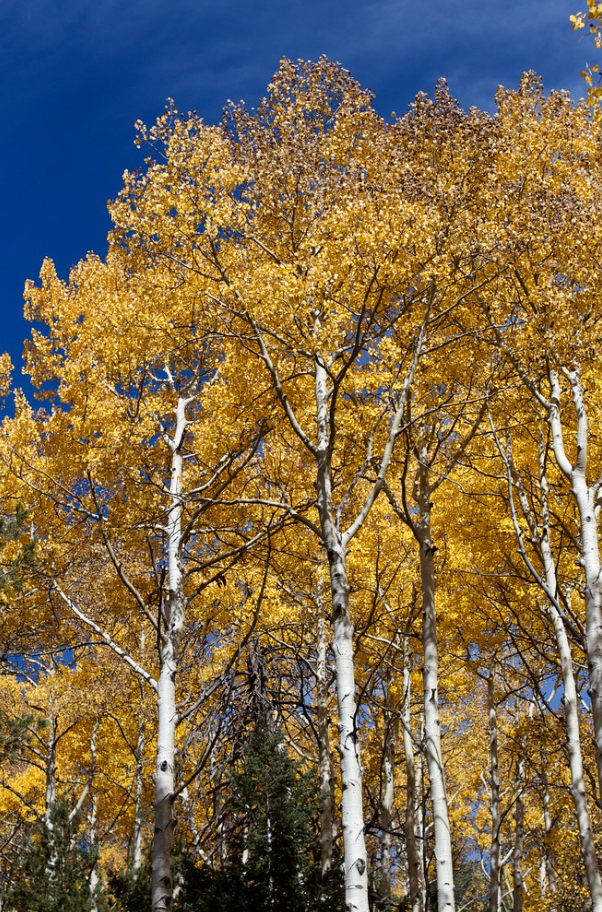Birch Tree vs Aspen

Although many people confuse birch trees with aspen trees, both plants are not the same. A notable difference between both trees is that birch has a papery bark that peels back, while aspen wood doesn't. Aspen leaves are heart-shaped, while birch leaves are oval-shaped and have tapering tips. Both leaves have a distinct green tint that turns yellow in fall. Here's a full side-by-side on birch trees vs aspen.
Table of Contents
Birch Trees Vs Aspen Trees: Everything You Need To Know
In this birch tree vs aspen tree comparison, we look at the difference in bark appearance, growth requirements, leaf appearance, and buds of both trees.

Credit: Everson
Birch Trees
Birch trees have many types, but the most common is the European birch or Common birch (Betula pendula). It is also commonly known as the White birch, Warty birch, European Weeping Birch, and Silver Birch. The tree belongs to the genus Betula, which contains nearly 60 species of shrubs and deciduous trees.
Bark Appearance
Birch bark is smooth and resinous. The white bark is also marked by lenticel, horizontal pores that allow gasses to pass through. It peels off in thin layers, revealing the wood beneath.
Older tree trunks have deeply furrowed and thick bark that breaks to form irregular plates. The short and slender branches give the tree a pyramidal shape, which can become pendulous or horizontal on older trees.
Leaf Appearance
Birch leaves are either triangular or egg-shaped. They have toothed margins and are arranged alternately on the tree's branches. Birch leaves have a beautiful green color and doubly serrate margins.
There are no hairs on the leaves. A birch leaf can be anywhere from 1 to 3 inches in length.
Buds
Birch buds are small, often only 4 millimeters long, and brown or glossy green in color. They have a slightly pointed shape.
The tree forms green, cream, or tan-colored flowers in the spring. They're shorter than an inch and give a showy appearance to the tree.
Birch trees are monoecious, which means that male and female flowers appear on the same tree. These flowers bloom in individual catkins, which are cylindrical clusters.
Climate and Location
Birch trees grow best in cool and northern climates with temperatures lower than 75 degrees F. They thrive in conditions where their root system is covered with snow in the winter. Most birch varieties grow in USDA Zones 2 to 7.
In the US, River Birch is commonly found in the eastern and midwestern states. Yellow Birch grows in Minnesota, Iowa, and northern Georgia, all through the Appalachian Mountains. Cherry Birch is native to the eastern US and grows primarily in north Georgia and Maine.
Growth Requirements
The birch tree requires acidic, sandy, well-drained, and moist soil. It grows well in full sun to partial shade. Some varieties, such as the European White Birch, can tolerate dry soil.
The tree must be kept moist consistently. Growers should invest in soaker hoses to keep the root system moist and cool or drip irrigation for trees. Alternatively, you can water the birch tree for about two hours every week. The water should soak at least the top two inches of the soil.
An underwater birch tree is prone to diseases and pest infestations. Another way to keep the soil cool is to add mulch at the base of the tree. However, the mulch should not touch the tree's trunk.
Birch trees do not need a lot of pruning. However, if you want to shape them, do it in the dormant season. Birch trees should not be pruned during spring or winter because they can bleed.
When pruning, do not cut more than 25% of the tree. Remove the branches growing straight upward from the tree trunk since they have weak attachments. Also, remove rubbing branches.
Brich does not need excessive fertilization. Only fertilize your tree in spring if it shows distress symptoms. Use a slow-releasing fertilizer and mix it with the soil above the root zone.
If the soil is highly alkaline, use an acidic fertilizer. Follow the manufacturer's instructions on the fertilizer to determine the amount to be used.
Did you know? Birch wood is used to make flooring, furniture, and cabinets.

Aspen Trees
Aspen is a mid-sized deciduous tree that can grow up to 80 feet in height, with a girth of 3 to 18 inches. Some old aspen trees are about 80 feet and have a diameter of 23 inches.
Aspen trees usually have a lifespan of 150 years, but some of them can grow for about 200 years. A pioneer species of Aspen is the Quaking Aspen, which can colonize an area quickly due to its fast growth.
These trees provide a habitat for many animals, including elk, deer, moose, hare, migratory birds, and black bears.
Bark Appearance
Aspen trees have smooth, yellow-white, yellow-grow, or green-white bark. The bark gets its green color from the chlorophyll inside it, which helps the tree photosynthesize. Aspen bark is relatively thin compared to other trees, but it may get rough as the tree becomes older.
Leaf Appearance
Aspen leaves are bright-green or yellow-green with a smooth texture. They turn yellow, orange, gold, or somewhat red during fall. These leaves are attached to the tree with a small stem called a petiole.
Aspen leaves are about 1.5 to 3 inches in length and have a pointed tip. Some species have oval leaves with lobed or toothed margins.
Aspen trees have a ''quaking'' appearance because their leaves make rustling noises in the wind. A simple way to differentiate between aspen species is to look at the tree's leaves. For example, Bigtooth
Aspen trees have larger leaves with widely spaced teeth on their margins, whereas the Quaking Aspen has leaves with fine teeth.
Buds
Aspen buds are small, like birch buds. They appear close to the twig and have a pointed shape. When opened, they look like a small paw of a gray cat, quite similar to the buds of a Pussy Willow.
The tree produces small flowers on 2-inch-long catkins. Appearing in early spring, the flowers bloom before the tree grows leaves. Unlike birch, Aspen is dioecious, so the female and male flowers grow on different trees.
After fertilization, the female flowers produce small fruit. It splits up to release cottony seeds spread across the area through the wind. If the seeds fall in moist soil, they germinate in a few days.
The buds and flowers of aspen trees differ based on the species. For example, the Korean Aspen tree has dangling flowers much longer than birch flowers.
Climate and Location
Aspen trees tolerate a wide range of climates, from basal plains and alpine forests to vegetational zones in the mountains. These trees can grow on talus slopes, dry areas, and moist soils.
Aspen trees are commonly found in Colorado and Utah. Some forests are also spread across the western states. Aspen forests provide habitat to elk, deer, moose, hare, and ruffed grouse. Both Aspen and birch are similar in their role as primary habitats for migratory birds and small animals.
Growth Requirements
An aspen tree needs soil with good drainage but doesn't have any other strict requirements. It can grow well in your garden loam too. The tree requires full sun to produce extensive foliage and flowers. It can tolerate some degree of shade too.
Growing in USDA Zones 1 to 6, the tree is not suited to southeastern regions. It doesn't do well in humid and hot environments.
As for watering, the soil must be kept evenly moist for the best growth. The soil should also be moderately rich in nutrients. You can fertilize your aspen tree with a balanced fertilizer in early spring.
The tree is dormant in winter, so that's the best time to prune it. The bark tolerates cuts well during this time. Strong and heavy snow can sometimes damage the branches and limbs of aspen trees. Prune the damaged branches to give your tree a well-structured shape.
If the aspen tree grows in an area with foot traffic underneath it, you'll have to monitor the tree regularly. Remove the lower limbs back to the collar to make room for walking underneath the tree.
Did you know? Aspen wood is used to make toys and furniture.
Sweet New Earth Final Say on Birch and Aspen Trees
The Aspen vs Birch tree comparison shows that both trees have different leaf and flower shapes. They are also different in their flowering habits. Birch trees are monoecious, while aspen trees are dioecious.
The choice between the two depends on where you want to plant them in your garden. Both trees grow fast, but Aspen grows an extra foot annually compared to birch.
A birch tree can grow about 1.5 to 2 feet per year. Most varieties have a lifespan of 50 years. Aspen trees grow well over 2 feet per year and also live longer.
Common varieties of aspen trees include the Grey Poplar, Quaking Aspen, Chinese Aspen, Swedish Aspen, and White Poplar. Some common birch cultivars are Yellow Birch, Gray Birch, Black Birch, River Birch, and Paper Birch. You can choose the variety for your garden based on your area's soil conditions and climate.

Christina Hernandez
Christina has done most of her research on environmental science but recently has changed her focus towards sustainable forestry. She has a passion for the outdoors and wants to spread that passion to the world.
Join our community!
Join to receive guides, insights, and the latest gardening deals!
